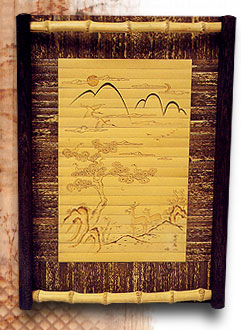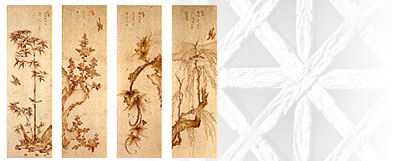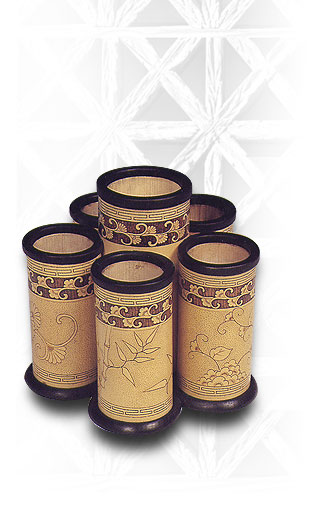exemplifies the high level the nakjuk artists of the Park Chang-gyu family attained in terms of techniques and artistic merit of pyrography. A 10-panel Folding Screen with Nakjuk (Bamboo Pyrography) Drawings of Birds and Plants Joseon Dynasty, 19th century Park Ju-dam A work by Park Ju-dam, a descendant of the nakjuk master Park Chang-gyu, this 10-panel folding screen contains nakjuk drawings of maehwa, orchids, banana trees, willows, grapes, bamboo and pine trees with birds. All drawings are made in the style of traditional folk art and a poem of a related theme is written in a calligraphic style at the top of each panel. Realistic touches on details and shading of these drawings create a unique atmosphere different from ordinary ink painting. Since its glory days during the Joseon period, nakjuk art has created many great artists, helping to establish itself as an important part of the traditional Korean handicraft used to decorate a variety of objects for daily use. Nakjukjang (‘Master Artist of Nakjuk Art’) Kim Gi-chan liked creating items such as tops, sleds and kites, even when he was very young, and displayed remarkable skills. Yet it was in his early twenties when he was an enthusiastic art student that he was introduced to the art of nakjuk. At that time he was staying in Songgwangsa Temple, one of the three most important Buddhist temples in Korea, where he immersed himself in its scenic natural surroundings. Here he met a woman who would become his lifelong companion and married her. His quest for art continued and he eventually studied in an art studio in the city of Gwangju, an experience that led him on the path of finding his future career. In 1982, Park Yong-gi, a master craftsman of decorative hand-knife making who happened to be a friend of the owner of the art studio where he studied art, introduced him to Yi Dong-ryeon, the first Master nakjuk artist. Actually, it was Park Yong-gi himself who originally wanted to learn nakjuk skills from Yi to use them to decorate the grips and sheathes of his bamboo hand-knives. But finding that Kim, a capable art student, would perform better than himself, he encouraged Kim to learn the art in the hopes that the youngster would later create magnificent decorations for his knives. Kim started to learn nakjuk, although he had to make the long trip between Damyang where Yi’s workshop was located and Songgwangsa where he lived. To be a competent nakjuk artist, one needs to draw figures or write letters on a bamboo surface with a hot indu before it cools down, ideally sitting cross-legged with the upper body upright. Because he wasn’t used to such a posture, he had to stand up quite often during his training to relieve the physical pain caused by the uncomfortable position, resulting in harsh scoldings from his tutor. The experience of his nakjuk education was bitter and severe, yet he was able to make progress day after day in the newly adopted art. His original plan was to learn the art for five years under the master artist, but sadly his plans changed when the senior artist died suddenly three years after Kim began his apprenticeship. The sadness of losing the master and his mentor became an obstacle on the road to learning the art. Now Kim had no choice but to teach himself for the remaining two years. View the master's works |
|||||||
|




















